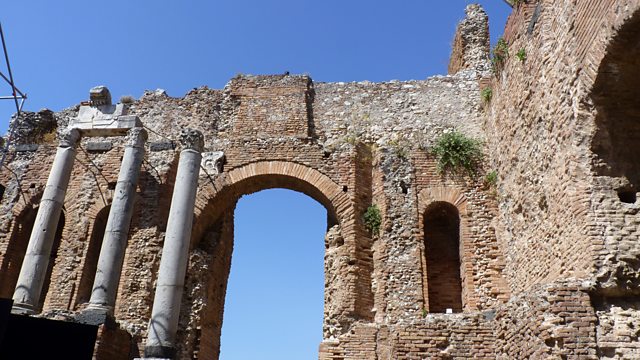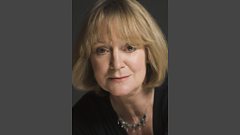
Ruins
Texts and music on the theme of ruins, with readings by Kenneth Cranham and Joanna David. With Derek Walcott, Philip Roth, Wordsworth and Rilke, plus Rachmaninov and Kurtag.
The actors Kenneth Cranham and Joanna David contemplate ruins in texts from anonymous Anglo-Saxon verse, telling of the ruined city of Aquae Sulis, which is most probably Bath, to the ruins of Empire, as vividly portrayed by Derek Walcott. They also reflect on the ruins of ancient lands like Egypt, romantic sham ruins, human ruins and ruined minds. This edition of Words and Music includes texts by Walter de la Mare to Philip Roth and Wordsworth to Rilke, and music reconstructed from ancient Rome, Rachmaninov and Kurtag.
Last on
More episodes
Previous
Next
Music Played
Timings (where shown) are from the start of the programme in hours and minutes
-
Desert Winds (Oman and the Arizona)
![]() 00:14
00:14Walter Maioli
Venus (composition using reconstructions of ancient Roman instruments)
Performer: Luce Maioli (voice & bells). Performer: Wjnand Simons (pan flute).- AMIATA ARNR1396.
- T16.
Shelley
Ozymandias, Kenneth Cranham (reader)
![]() 00:03
00:03Sergey Rachmaninov
Prelude in F sharp minor, Op.23 No.1
Performer: Nikolai Lugansky (piano).- ERATO 8573 85770-2.
- T2.
James Leigh Hunt
The Nile, Joanna David (reader)
![]() 00:06
00:06Kurtag
Aus der Ferne III
Performer: Keller Quartet.- ECM 1598 453 258-2.
- T1.
Anon (Anglo-Saxon), ed. Michael Alexander
The Ruin (extract), Kenneth Cranham & Joanna David (readers)
![]() 00:09
00:09Stravinksy
Allegretto (Dumbarton Oaks)
Performer: English Chamber Orchestra. Performer: Colin Davis (conductor).- DECCA 425 622-2.
- T2.
Geoffrey Grigson
Sham Ruins, Joanna David (reader)
![]() 00:13
00:13Francis Poulenc
Une ruine coquille vide (tel jour telle nuit)
Performer: Ian Bostridge (tenor). Performer: Julius Drake (piano).- EMI 557609 2.
- T16.
Walter de la Mare
The Corner Stone, Kenneth Cranham (reader)
![]() 00:16
00:16Norgard
Lento e rubato (Roads to Ixtlan)
Performer: Raschèr Saxophone Quartet.- BIS CD 1153.
- T8.
Hardy
Tess of the dUrbervilles (Chapter 58, extract), Joanna David (reader)
![]() 00:19
00:19Karlheinz Stockhausen
Stimmung (excerpt)
Choir: Singcircle. Director: Gregory Rose.- HYPERION CDA66115.
- T49-51.
![]() 00:23
00:23Selma, after Palestrina
Vestiva hi colli
Performer: Hille Perl (viola da gamba). Performer: Lee Santana (lute).- BMG 05472 77502 2.
- T10.
Amy Lowell
The Dusty Hour-Glass, Joanna David (reader)
![]() 00:28
00:28Lambert
The Ruin of the Ku-Su Palace
Performer: Yvonne Kenny (soprano). Performer: Malcolm Martineau (piano).- KTC 1140.
- T24.
Charles Mair
Ruins, Kenneth Cranham (reader)
![]() 00:30
00:30Ludwig van Beethoven
Largo assai ed espressivo (Piano Trio in D, Op.70 No.1 'Ghost')
Performer: Beaux Arts Trio.- PHILIPS 434 146-2.
- T7.
John Clare
Temple of Minerva, Joanna David (reader)
![]() 00:42
00:42Trad, orch. Casals
El Cant dels ocells (The Song of the Birds)
Performer: Pablo Casals (cello). Performer: Prades Festival Orchester.- CBS MPK 46724.
- T11.
![]() 00:45
00:45Michael Vetter
Breathing Wind
Performer: Michael Vetter & The Overtone Choir.- AMIATA RECORDS ARNR 0192.
- T2.
Philip Roth
Everyman (extract), Kenneth Cranham (reader)
![]() 00:49
00:49Medieval Anon (Armenian)
Akna krunk (Chant d'exil)
Performer: Haig Sarikouyoumdjian (duduk 1). Performer: Georgi Minassyan (duduk 2).- ALIA VOX AVSA 9892.
- T2.
![]() 00:52
00:52Rautavaara
Andante moderato (Dances with the Winds)
Performer: Petri Alanko (flutes). Performer: Lahti Symphony Orchestra. Performer: Osmo Vanska (conductor).- BIS CD 1038.
- T7.
Yeats
Sailing to Byzantium, Kenneth Cranham & Joanna David (readers)
![]() 00:58
00:58Maurice Ravel
Oiseaux tristes (Miroirs No.2)
Performer: Pierre-Laurent Aimard (piano).- DG 477 8770.
- T6.
Wordsworth
Composed among the Ruins of a Castle in North Wales, Joanna David (reader)
![]() 01:03
01:03Gabriel Fauré
Dans les ruines d'une abbaye, Op.2 No.1
Performer: Jean -Paul Fouchecourt (tenor). Performer: Graham Johnson (piano).- HYPERION CDA67336.
- T3.
Rilke
Belltowers Song (No.26), Joanna David (reader)
![]() 01:05
01:05Elliot Carter
Fragment (1994)
Performer: Arditti Quartet.- AUVIDIS MO 782091.
- T20.
Derek Walcott
Ruins of a Great House, Kenneth Cranham (reader)
![]() 01:10
01:10John Dowland
Aloe [68] (The Trumbull Lute Book)
Performer: Jakob Lindberg (lute).- BRILLIANT 93698.
- CD4T12.
Rossetti
Ruin, Joanna David (reader)
![]() 01:13
01:13Leos Janáček
A Recollection
Performer: Andras Schiff (piano).- ECM 461660-2.
- T22.
Walter de la Mare
Not Only, Kenneth Cranham (reader)
Producer's Note
The world is full of ruins that give us a tantalizing glimpse into past civilisations and cultures, and of what might once have been.�� There are ruined abbeys, castles and manors, abandoned temples, curious edifices like Stonehenge, and the statue to Ozymandias that opens this edition of Words and Music.�� As civilisations slowly forge onward, the world makes space for more and more ruins.��
��
Ruins can be at once beguiling and beautiful. ��They also create a psychological space for contemplation and recollection.�� I wanted to evoke the sound world of ruins, which I have done in a number of ways.�� There are pieces of music entitled ‘fragment’, implicitly part of something bigger that we will never hear, and there are pieces like Janacek’s ‘recollection’ for piano, Kurtag’s ‘Aus der Ferne III’ (From the Distance III) and the ethereal slow movement of Beethoven’s ‘Ghost’ trio.�� As ruins merge into the natural world, making a home for wildlife, I have included some music about birds, and I have also recreated the windy soundscape that many ruins inhabit by mixing desert winds with Maoli and using the wind and vocal music of Nordgard, Rautavaara, Stockhausen and his disciple Michael Vetter.
��
This programme begins with Shelley’s poem ‘Ozymandias’, which tells the story of a statue from an antique land that is standing half sunk in the desert.�� Winds from the Arizonian and Oman deserts swirl around the haunting sound of a pan flute, which is Walter Maioli’s reconstruction of the sounds known to ancient Romans.�� These sounds are combined to create a sense of the ancient world, which merge into the serene rippling of a Rachmaninov piano prelude, mirroring the words of James Leigh Hunt’s poem, ‘The Nile’.��
��
One of the earliest known Anglo-Saxon poems is entitled, ‘The Ruin’.�� It is the description of a deserted Roman city, most probably Aquae Sulis (the roman Bath), and was discovered on two leaves badly scarred by fire.�� I wanted to create an audio ruin, using fragments from this poem which, because of the scarred leaves, is already a fragment, and these are set to Kurtag’s string quartet, ‘Aus der Ferne III’, like an echo from the past.��
��
In complete contrast to the ancient world are those sham ruins, or artificial ruins, loved in the 18th century.�� Stravinsky’s neo-classicism in ‘Dumbarton Oaks’, as a pastiche of older music, perfectly suits Geoffrey Grigson’s description of these shams.
��
The scene of Thomas Hardy’s ‘Tess of the d’Urbevilles’, in which Angel and Tess stumble across Stonehenge, is accompanied by the eerie sound of Norgard’s ‘Roads to Ixtlan’ for saxophone quartet and then Stockhausen’s Stimmung, a chant performed in a circle to represent the iconic stone circle.
��
Amy Lowell’s ‘The Dusty Hour-Glass’ and Charles Mair’s ‘Ruins’ are two beautiful poems that depict the ruination of man’s mind, one set against an overgrown garden and the other in the wild forest.�� They lead into Beethoven’s ‘Ghost’ trio, which acts as a bridge to two texts about human ruins: John Clare’s ‘Temple of Minerva’ and a passage from Philip Roth’s ‘Everyman’.
��
The programme then returns to the theme of ancient ruins with Yeats’ poem, ‘Sailing to Byzantium’, accompanied first by a traditional Armenian song of exile for two hauntingly beautiful duduks, and then Rautavaara’s ‘Dances with the Winds’.�� Elliott Carter’s 1994 ‘Fragment’ for string quartet provides a dark and oppressive atmosphere for Derek Walcott’s poem about the demise of the British Empire, ‘Ruins of a Great House’.��
��
Romantic visions of ruins, as depicted by Rossetti and De la Mare, end the programme and are connected by Janacek’s ‘A Recollection’.
��
Elizabeth Arno (producer)
Broadcast
- Sun 23 Feb 2014 17:30�鶹�� Radio 3
The hidden history of plant-based diets
Books website
Get closer to books with in-depth articles, quizzes and our picks from radio & TV.
Gallery



